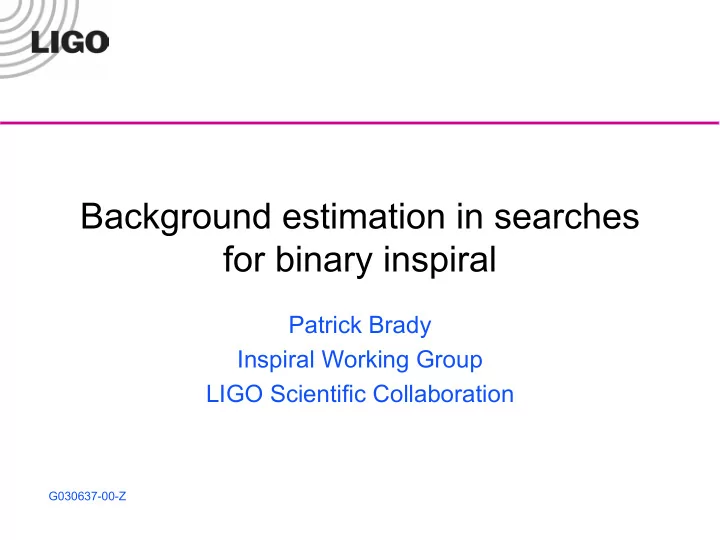

Background estimation in searches for binary inspiral Patrick Brady Inspiral Working Group LIGO Scientific Collaboration G030637-00-Z
Inspiral search pipeline • Data Quality cuts applied up front » Analyze only science mode data • Multi-interferometer follow up on coincident triggers. » ( Talk by Bose ) • Single interferometer vetoes applied to triggers from each interferometer » ( Talk by Christensen and Shawhan ) • Background Estimation » Time slide Hanford data relative to Livingston data G030637-00-Z 11/10/2003 GWDAW -- 1 2
Coincidence criteria • Triggers from Livingston are used to search the corresponding Hanford data • Check for coincidence between the Livingston and Hanford triggers. • The coincidence algorithm was: » 1. Triggers must be coincident in time to within 11 ms. » 2. Each mass parameter in the template must be the same to within 0.03 solar masses. » 3. Compare distances measured at Livingston (D L ) and Hanford (D H ) G030637-00-Z 11/10/2003 GWDAW -- 3
Tuning the amplitude cut • Errors in distance estimates expected to decrease with Missed injections in coincidence increasing SNR |D L - D H |/D L < ε / ρ H + κ ε and κ tunable constants • Relax amplitude cut to allow detection of these Milky Way events D H /D L G030637-00-Z 11/10/2003 GWDAW -- 4
Time-lag results: preliminary results using small bank LLO triggers in coincidence with LHO Take a closer look at these candidates Livingston SNR LHO triggers in coincidence with LLO G030637-00-Z 11/10/2003 GWDAW -- 5 Hanford SNR
Time-lag analysis: SNR in each detector Coherent two detector SNR=10 Hanford SNR Large SNR in Livingston coincident with low SNR at Hanford Livingston SNR G030637-00-Z 11/10/2003 GWDAW -- 6
Time-lag analysis: triggers versus injections Simulated injections of binary inspirals in Andromeda Raise SNR threshold in Hanford to 6 Hanford SNR Livingston SNR G030637-00-Z 11/10/2003 GWDAW -- 7
Time-lag analysis: full bank & adjusted thresholds No. of distinct candidates after 1 second clustering Two out of 18 time-lags have coincidence in templates of same mass G030637-00-Z 11/10/2003 GWDAW -- 8
Time-lag analysis: full bank & adjusted thresholds G030637-00-Z 11/10/2003 GWDAW -- 9
Concluding remarks • Where to next: » Complete ~100 time-shifts on playground data » Check for problems with background estimation using time-shifts » Run time-shift analysis on all data to be used in search – determine network SNR threshold – compare to extrapolation from playground • Search for binary inspiral » Use background estimate from time-shifts on full data set » Search for candidate events » Determine rate limit based on efficiency, background, and number of detections G030637-00-Z 11/10/2003 GWDAW -- 10
Recommend
More recommend